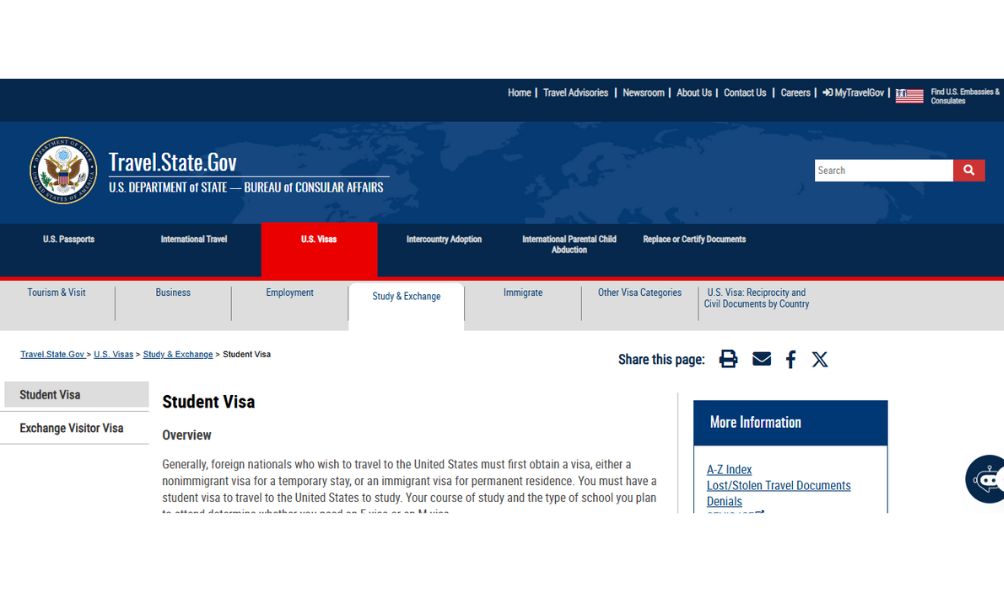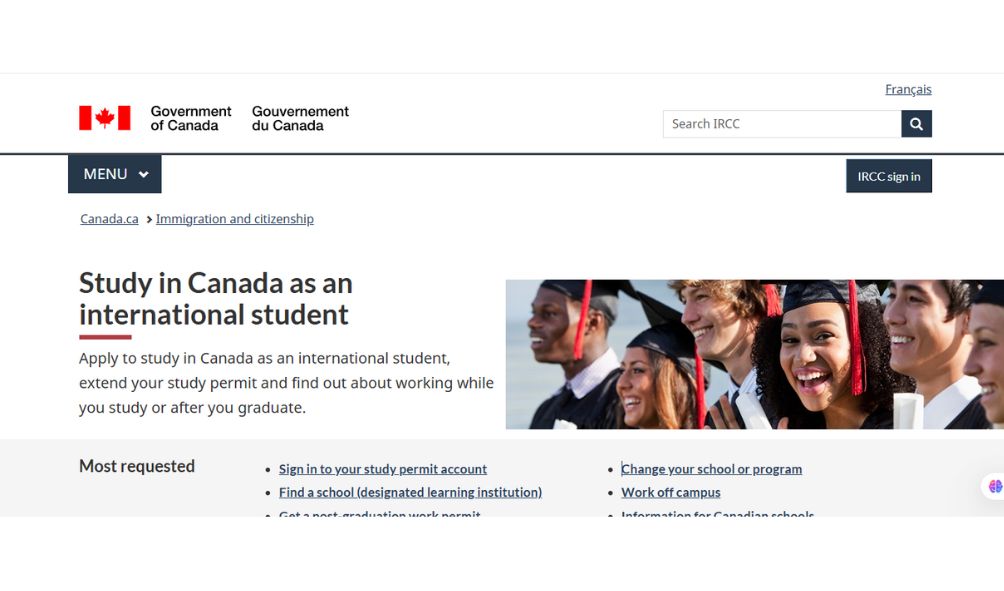Pursuing higher education in the United States in 2025 continues to be a popular goal for international students. To do so, one must navigate the USA Student Visa 2025. In general, new international students must secure an F-1 student visa, which allows full-time study at U.S. colleges or universities.

To obtain a U.S. study visa in 2025, a student must first be accepted by an SEVP-approved school, which issues a Form I-20. After receiving it, they must pay the SEVIS fee (US$350 for F-1), complete the DS-160 application, and schedule a visa interview.
The interview waiver period has decreased from 48 months to 12 months, and expanded social-media screenings are now conducted, potentially leading to more in-person interviews and longer processing times. Therefore, thorough preparation is essential.
USA Student Visa 2025
International students can look forward to world-class education and research opportunities in the U.S. The F-1 visa not only permits study but also allows optional practical training (OPT) for up to 12 months after graduation (and an extra 24 months for STEM degrees). This practical experience can greatly enhance future careers.
In contrast, other visa types exist for different programs: the J-1 visa is for government-approved exchange programs (including student exchanges, internships, and research visits), often sponsored by universities or cultural organizations.
The M-1 visa serves those attending vocational or technical schools, but it does not allow on-campus work and is limited to the length of the training program. Each visa category has specific rules, but all require proof of acceptance by a qualifying U.S. institution and evidence of sufficient funds and intent to return home after studies.
Types of U.S. Student Visas
- F-1 Visa: The F-1 visa is the most common for degree programs, allowing full-time study at accredited institutions. It requires a Form I-20 from the school and enrollment in SEVIS. Holders are also eligible for Optional Practical Training (OPT) after graduation.
- J-1 Visa: The J-1 visa is for participants in approved educational and cultural exchange programs, such as university study, language training, internships, or research, often sponsored by the U.S. Department of State. Some categories require a two-year home-country residency afterward. Canadian and Bermudian citizens do not need a visa but must present Form DS-2019 for admission.
- M-1 Visa: For non-academic or vocational studies (e.g., technical courses, mechanical training, or flight school). M-1 students cannot work on campus or off-campus during their studies. The M-1 visa is generally issued for the length of the training program (up to one year, extendable up to three years). It requires a Form I-20 for M-1 applicants.
Each visa type requires similar core documentation, but applicants should double-check the specific rules (such as work restrictions) that apply to their category.
Note: All visas must match the program type on the Form I-20 or DS-2019 (F or M on the I-20, J on the DS-2019).
Eligibility and Requirements
To qualify for a U.S. student visa in 2025, applicants generally must meet these core requirements:
Acceptance by a SEVP-Approved School:
You must first apply to and be accepted by a U.S. school certified by the Student and Exchange Visitor Program (SEVP). Upon acceptance, the school will enter your record in SEVIS and issue you a Form I-20 (for F-1/M-1) or Form DS-2019 (for J-1).
SEVIS Fee Payment:
Before your interview, you must pay the SEVIS I-901 fee (US$350 for F-1/M-1, US$220 for J-1). This fee funds the SEVIS database. After payment, print the receipt; it is required at the visa interview.
Online Visa Application (DS-160):
Complete the DS-160 form online accurately, upload a compliant digital photo, and print the confirmation page. Keep in mind: the information on your DS-160 must match the I-20 exactly (name spelling, birthdate, etc.).
Passport:
Your passport must be valid for at least six months beyond your intended stay in the U.S. It should have at least one blank page for visa stamping.
Visa Interview Appointment:
Schedule an interview at the nearest U.S. embassy or consulate if you’re a visa applicant aged 14-79. Bring all required documents. If eligible for an interview waiver (e.g., renewing an F/J visa expired within 12 months), you may avoid an interview, but note that the 2025 policy has tightened this window.
Financial Evidence:
Demonstrate you have sufficient funds to cover tuition and living expenses for the first year (or entire program). Acceptable proof includes bank statements, scholarship letters, grant award letters, or affidavits of support. Showing financial stability is mandatory.
Additional Supporting Documents:
Include documents that strengthen your case, such as academic transcripts, diplomas, standardized test scores (TOEFL, IELTS, SAT, GRE), a resume/CV, and a Statement of Purpose outlining your study plans and career goals. Additionally, provide ties to your home country, like property deeds or an employer’s letter, to confirm your intent to return.
Passport-Style Photo:
Bring two recent passport-sized photos that meet U.S. visa specifications (plain background, no glasses, etc.). If you could not upload a photo with the DS-160, bring printed photos as instructed.
The consular officer will expect all these documents at the interview. Incomplete paperwork or inability to explain your academic plans and finances can lead to a denial. All information must be truthful and well-organized.
Application Process (Step-by-Step)
Gain Acceptance:
Apply to your chosen U.S. school(s). Once accepted, the school’s international office will register you in SEVIS and send your Form I-20 (for F/M visas) or Form DS-2019 (for J visas). Review the form for accuracy and sign it alongside the school official.
Pay SEVIS Fee:
Go to the I-901 website and pay the SEVIS fee (I-901). Save the receipt; you must bring it to the visa interview.
Complete DS-160:
Fill out the online DS-160 nonimmigrant visa application on the U.S. Department of State website. Carefully enter all details as per your documents. Upload the required photo or be prepared to provide a printed photo at the interview if the upload fails. Print the DS-160 confirmation page with the barcode.
Pay Visa Application Fee:
Pay the MRV fee (currently US$185 for F, M, and J visas). Keep the payment receipt. This fee is non-refundable, even if the visa is denied.
Schedule a Visa Interview:
Book an appointment online at your nearest U.S. embassy/consulate. Wait times vary by location and season, so do this early. For new students, the interview can be scheduled up to 365 days before the program start.
Gather Documents:
Collect all required papers: valid passport, signed I-20/DS-2019, SEVIS fee receipt, DS-160 confirmation, visa fee receipt, photos, acceptance letter, academic records, and proof of funds. Having a clear folder or binder can help keep papers organized.
Attend the Interview:
Arrive early on your interview date with all documents. You’ll undergo fingerprinting and an interview with a consular officer. Be honest and concise when answering questions about your school choice, study plan, funding, and ties to home. Practice demonstrating your intent to return home, emphasizing strong ties like family, job offers, or community, as this can improve your chances of approval.
Await Decision:
After the interview, your visa application will be processed. If approved, your passport will be returned to you with the visa stamp. Processing times vary it can be a few days to a few weeks, depending on whether additional administrative processing is needed. Once approved, double-check the visa details for any errors.
Once you have your visa, arrange your travel. You can enter the U.S. up to 30 days before your program starts. Keep all original documents (passport with visa, signed I-20, financial documents) in your carry-on for Customs. After entering, protect your I-94 record and maintain your F, J, or M status by studying full-time and following campus rules.
Visa Duration and Work Options
- F-1 Visa: Valid for the duration of your academic program (as indicated on the I-20) plus a 60-day grace period to depart or change status. During study, you may work on campus part-time. After graduation, you become eligible for OPT work authorization (up to 12 months; STEM graduates may apply for an additional 24-month extension).
- J-1 Visa: Valid for the length of your exchange program plus a 30-day grace period. Some J-1 categories allow paid academic training during or after studies (similar to OPT). Note that many J-1 visas impose a two-year home-country residency requirement after completion if certain criteria apply.
- M-1 Visa: Valid for your vocational program length (up to 1 year, extendable up to 3 years) plus a 30-day grace period. M-1 students cannot work during their studies (no CPT or OPT). Any practical training must be specifically authorized as part of the vocational program and is limited in duration.
Maintaining status is crucial: you must remain enrolled full-time and update the school with any address or program changes. If you drop below full-time without authorization, you will fall out of status and can lose your visa.
Visa Fees and Processing Times
- SEVIS Fee: $350 for F-1/M-1 students and $220 for J-1 exchange visitors. Pay it as soon as you receive your I-20/DS-2019.
- Visa Application Fee (MRV fee): $185 for F, M, and J visa categories. This fee is paid before the interview and must be evidenced at the appointment.
- Issuance Fee (if any): Some countries’ nationals pay an additional visa issuance fee after approval (for example, in some reciprocity schedules). Check the embassy website for your country.
Processing Time:
Once your interview is completed, administrative processing usually takes a few days, but it can sometimes extend to weeks if extra security checks are needed. In 2025, expect additional time due to the new expanded vetting procedures. It is wise to apply as early as possible (but not more than a year before your start date).
2025 Policy Updates and Changes
Several recent changes in 2025 affect student visa applicants:
- Expanded Online Vetting: In June 2025, the Department of State mandated consulates to enhance social media screening for F, M, and J visa applicants. Applicants must disclose all social media accounts, which may be reviewed for concerning content such as terrorism support or hate speech.
- Interview Waiver Tightened: As of Feb 18, 2025, the rule allowing interview waivers only when a previous visa expired within 12 months was reinstated (down from the 48-month window used post-COVID). Therefore, fewer applicants can skip the interview, and many more must appear in person.
- Suspension & Resumption of Appointments: In late May 2025, the State Dept temporarily paused scheduling new F/M/J visa interviews to implement these vetting changes. Scheduling resumed in late June, but with limited appointment slots initially. Expect that embassies are working through backlogs, which could lengthen wait times for some locations.
- Executive Orders: The U.S. executive branch has signaled stricter vetting for incoming travelers. For example, a June 4, 2025, Presidential Proclamation advises visa applicants from certain countries to reconsider travel due to enhanced security measures. Applicants from any country should stay informed, as these policies can change rapidly.
In summary, the core steps for obtaining a student visa remain the same, but applicants in 2025 should prepare for additional scrutiny. Ensure your online presence is appropriate, keep all documents pristine, and start the process well in advance of your program start date.
Frequently Asked Questions
What is the main U.S. student visa for degree programs?
The F-1 visa is the primary visa for students enrolling in full-time academic or language programs at U.S. institutions. It requires a Form I-20 from an accredited school. The F-1 visa allows study and Optional Practical Training (OPT) after graduation. In contrast, the J-1 visa covers exchange programs, and the M-1 visa is for vocational studies.
What documents do I need for the visa interview?
Bring a valid passport, your Form I-20 (or DS-2019) signed by you and your school, the SEVIS fee receipt, DS-160 confirmation page, visa fee payment receipt, passport photo, acceptance letter, academic records, and proof of financial support. Also, bring any additional documents like test scores or ties to your home country that support your case.
How much does the SEVIS fee cost?
As of 2025, the SEVIS I-901 fee is $350 for new F-1 and M-1 students, and $220 for J-1 exchange visitors. This fee must be paid before your visa interview, and the receipt is required during your interview.
Can I work while studying on an F-1 visa?
F-1 students can work part-time on campus during school and full-time during breaks. They can also engage in off-campus work through Curricular Practical Training (CPT) for academic credit while studying and Optional Practical Training (OPT) for up to 12 months post-graduation, with a 24-month STEM extension possible. J-1 students have access to Academic Training, while M-1 students have limited work permission for occasional authorized training.
What changed for student visas in 2025?
Key updates include stricter interview policies and security checks. Interview waivers have been restricted to visas that expired within 12 months. The U.S. now performs broader social-media checks for all student visa applicants, which may slow down processing. It’s recommended to apply well early and be ready for more extensive vetting.
How long can I stay on a student visa?
Your stay (and visa validity) generally covers the length of your academic program. F-1 and J-1 visas end upon program completion, plus a grace period (60 days for F-1, 30 days for J-1) to depart or change status. M-1 stays last as long as your vocational training (up to one year, extendable). Always check your I-20/DS-2019 and I-94 records to confirm your authorized stay.
MORE RELATED CONTENT:
Italy Student Visa 2025 – Application Process
How to Get a Student Visa for Canada in 2025 (Study in Canada)
Canada Work Visa Application Process 2025
Essential Guide to Applying for a UK Student Visa



